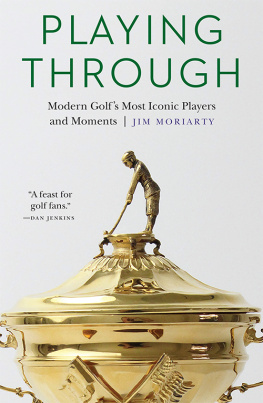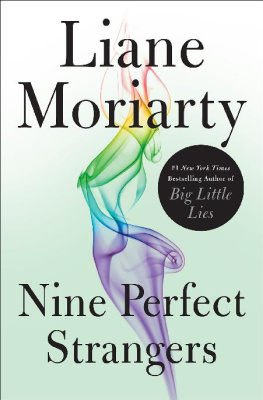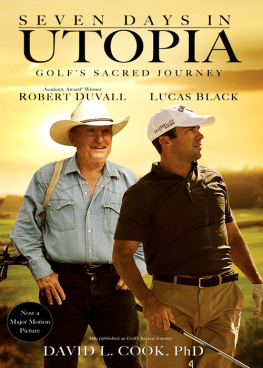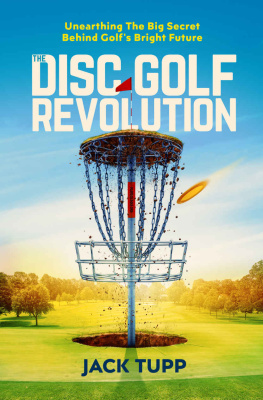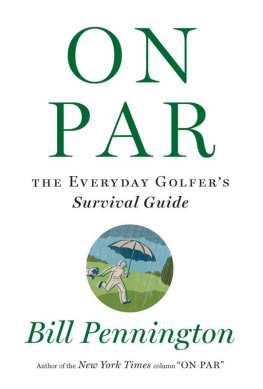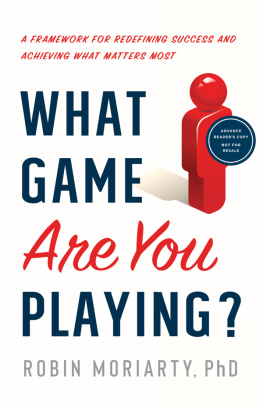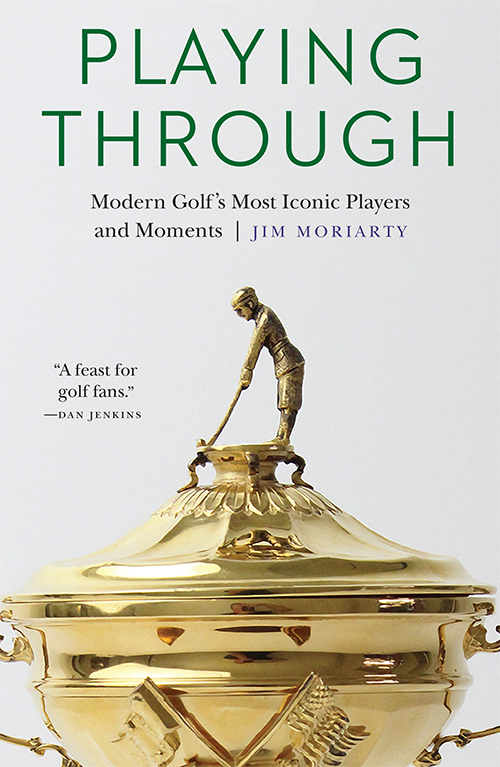
Jim Moriarty and I traveled this same trail covering these golf legends. These excellent essays indicate that he must have paid more attention than I did. This book is a feast for golf fans.
Dan Jenkins, author of Unplayable Lies and Semi-Tough and member of World Golf Hall of Fame
Jim Moriarty has amassed a beautiful composition of essays that will delight his readers and make me proud that he is my friend.
Gary McCord, CBS commentator
Any collection of Jim Moriartys writings on golf is reason to celebrate for any true fan of the game. He writes effortlessly about [players] trials and triumphs in a fullbodied manner that recalls the finest storytellers of the past century. Heres one for your reading chair and library, a true perennial.
James Dodson, author of Final Rounds and American Triumvirate
Playing Through
Playing Through
Modern Golfs Most Iconic Players and Moments
Jim Moriarty
University of Nebraska Press Lincoln and London
2016 by Jim Moriarty
Cover designed by University of Nebraska Press; cover image Worthridge Auctions and Retail, www.worthridge.com
All rights reserved
Library of Congress Cataloging-in-Publication Data
Names: Moriarty, Jim.
Title: Playing through: modern golfs most iconic players and moments / Jim Moriarty.
Description: Lincoln: University of Nebraska Press, 2016.
Identifiers: LCCN 2016011020
ISBN 9780803278653 (hardback: alk. paper)
ISBN 9780803295452 (epub)
ISBN 9780803295469 (mobi)
ISBN 9780803295476 (pdf)
Subjects: LCSH : GolfHistory. | GolfersBiography. | BISAC : SPORTS & RECREATION / Golf.
Classification: LCC GV 963 . M 67 2016 | DDC 796.352dc23
LC record available at https://lccn.loc.gov/2016011020
The publisher does not have any control over and does not assume any responsibility for author or third-party websites or their content.
For Maya and Hayley
Contents
This book would not have been possible without relying on the work I did over a thirty-five-year period for Golf Digest and Golf World, and for that, Im deeply grateful. Im especially thankful and privileged to have had the opportunity to do it in the first place. These days the number of resources available with a keystroke or two is vast, but some works are especially valuable. The series of annuals created for International Management Group and Mark H. McCormack by the late, great Bev Norwoodwith contributing writers too numerous, and sometimes too anonymous, to mentionis worth every inch it occupies on the bookshelves. The biographies of Greg Norman and Seve Ballesteros by Lauren St. John and Melanie Hausers book with Ben Crenshaw are timeless resources, as are the autobiographies of Nick Faldo and Jack Nicklaus, the latter written with Ken Bowden. Sports Illustrateds Vault is a deep well of knowledge produced by a long list of great writers, from Dan Jenkins to Jaime Diaz. The interviews compiled and archived by ASAP Sports Transcripts are as rich a vein of primary material as exists in the game. The exquisite My Shot series, written by Guy Yocom for Golf Digest, is the finest compilation of interviews ever produced in the sport and the source of countless nuggets. And, when it comes to the history of golf, Bill Fields is nothing short of a divining rod.
In 1982 the Pebble Beach Golf Links on the Monterey Peninsula hosted the U.S. Open Championship and played to 6,815 yards and a par of seventy-two. In 2015, in the second round of the U.S. Open, Chambers Bay Golf Course on Puget Sound played to 7,695 yards and a par of seventy. Perhaps never in the six-hundred-plus-year history of golf has the game changed as much as it has in its last thirty or so years. If you need to find a fall guy, blame the computer chip.
No doubt there has been golf instruction since one Scottish shepherd wielded a crook more proficiently than another. From H. B. Farnies book in 1857 to Bobby Joness newsreels to high-speed photographic sequences and videotape, the golf swing has been as dissected as any single athletic move. Now, launch monitors can tell you everything about the flight of a golf ball except whether the eyes of the person who hit it are blue or brown. In 1982 drivers were polished persimmon, almost works of art. Now, theyre outsized laboratory experiments the size of small pumpkins fashioned out of titanium with a measurable coefficient of restitutionsomething that guys in 1982 would have thought was the time it took to get rid of a hangover. Today, golf balls are engineered. In 1982 some guys carried little steel rings to make sure they were round. Back then golfers didnt travel with instructors or sit in the dark with sports psychologists or get their menus from nutritionists or have their backs pulverized by chiropractors or their abs ripped by personal trainers. If you saw an agent at all, it was because someone needed to fill the field in the Philippines in November and was prepared to pay handsomely, maybe several thousand dollars, to do it. These days every player has his or her team.
Are golfers more fit now? Sure, but how much clean and jerk is too much? Are they mentally more able to compete at the highest level? Well, that depends on whom youre talking about and whether you think you can buy self-belief or, at the very least, rent it for a while. Has stretching championship venues like Gumby made the game better or just more expensive to maintain? Have sports psychologists slowed play with preshot routines and visualization? Are drivers that cost as much as the used VW beetle I bought right out of college in the early 70s worth the price, or have they priced the game out of reach? Those werent even considerations thirty years ago.
Nostalgia, however, is a losing bet. Distance, time, cost, metadata, all the things that are right or wrong about the modern game, failed to do one thingchange it fundamentally. During my time covering golf, most of my colleagues and virtually all of the players were introduced to the game as children. I came to it as a sportswriter covering a beat no one else wanted and grew to understand that golf tests an athletes insides like no other sport. To be able to perform as if that performance meant nothing more than stopping at the corner convenience store when it actually means all the world is an immeasurable talent some seem born into, while others forge it in failure. The essays that follow are about my people, the players I saw revealing the best of themselves in the biggest moments. Whatever it is that made Jack versus Tom great in 1982 hasnt been altered one whit. The fundamental things still apply, as time goes by.
Last Tango in Pebble Beach
Whenever television cameras peer down from a blimp swimming through the air like a floating dolphin above Pebble Beach capturing the scenery of the Monterey Peninsula, some network wag will invariable trot out the old line attributed to Robert Louis Stevenson describing this stretch of majestic coastline as the most felicitous meeting of land and sea in creation. Stevenson must have made up his mind fast.
The author of adventures like Treasure Island and Kidnapped shipped out of Scotland on the Devonia in August 1879 in hot pursuit of a married woman, Fanny Osbourne, whose husband was a crackerjack philanderer himself. After arriving in New York and journeying across North America by rail, Stevenson caught up with Fanny in Monterey, the capital of Alta California before the Mexican-American War. The tiny town with its heavy Spanish and Mexican influence had three streets with wooden walkways and, according to the haggard and nearly penniless writer, a population... about that of a dissenting chapel on a wet Sunday in a strong church neighborhood. He was not greeted warmly by Fanny, who had yet to actually set her divorce from her debauched husband into motion. So, the sickly, impoverished, and love-stricken Stevenson took a horse and pack and headed off into the unfamiliar pine-covered hills above Carmel, where he became delirious and nearly died before being rescued by a couple of goat ranchers, one a seventy-two-year-old Mexican War veteran and the other an Indian named Tom. Nursed back to what passed for health in a man who always appeared, if not on deaths door, to have a foot on its welcome mat, Stevenson moved into Monterey and took a job writing for the

